QCF: Pokémon X/Y
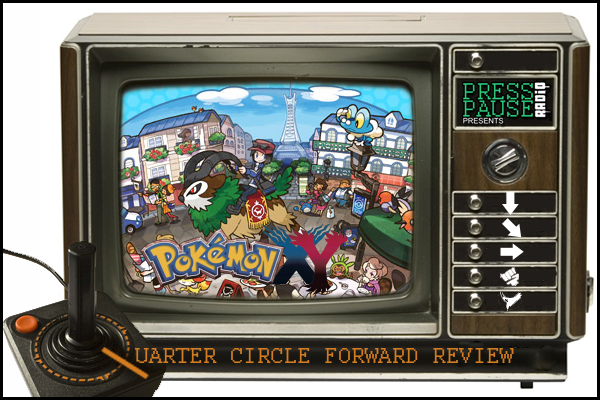
 or the last seventeen years, a series that hinged so much on its formulaic design has not only gone on to endure, but prosper and become one of the most successful properties in media today. The sixth generation of the Pocket Monsters made it’s very first simultaneous debut across the world on the Big N’s new edition of the iconic dual-screened pocket-sized game box, and well, it’s still sort of a big deal.
or the last seventeen years, a series that hinged so much on its formulaic design has not only gone on to endure, but prosper and become one of the most successful properties in media today. The sixth generation of the Pocket Monsters made it’s very first simultaneous debut across the world on the Big N’s new edition of the iconic dual-screened pocket-sized game box, and well, it’s still sort of a big deal.
I’ll be honest with you guys, the previous iteration didn’t impress me in the slightest, it had the exact opposite effect—a sentiment that’s argued even among the most dedicated of fans of its respective community. However, The latest X and Y installment in the Pokémon dynasty is different.
Instead of pandering to systematically compulsory reaction of shoving new monsters and gimmicks to the fold—X and Y tone it down and balance it out with some of the sharpest refinements the formula yet, making it both, the most appealing and the most polished to enter the fold.
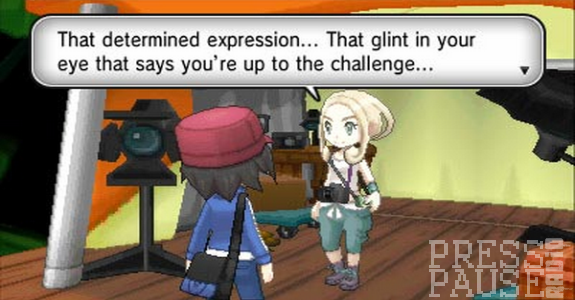
Immaculate balancing; this is the component that elevates the X and Y edition above all of its predecessors. Despite its widespread appeal commercially among a variety of demographics, the barrier of entry to knuckle down with the Pokés was ironically a tall order, which is the factor that set the clear 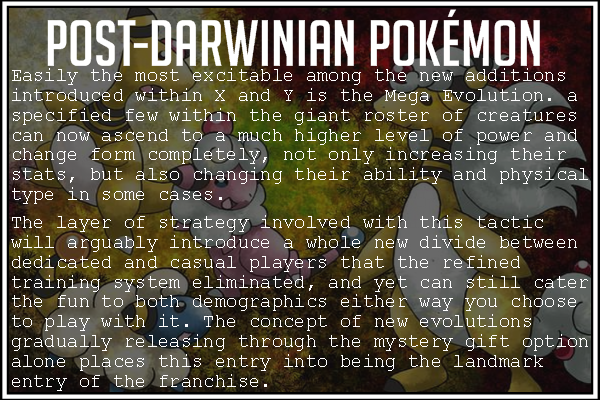 divide between a player, and a fan within the insular community it’s built within the last decade; all of that’s gone now—for the better. This kind of balancing in play results in a consistent, and ever fluid low of play from the moment you name your character to the six feet between you and the League Champion before the fateful battle; the balancing is essentially engineered to keep everything you do moving and does it fast to boot.
divide between a player, and a fan within the insular community it’s built within the last decade; all of that’s gone now—for the better. This kind of balancing in play results in a consistent, and ever fluid low of play from the moment you name your character to the six feet between you and the League Champion before the fateful battle; the balancing is essentially engineered to keep everything you do moving and does it fast to boot.
For example, one of the biggest changes to the series is the collection of changes to the dynamics in how you can now raise your team of six monsters easier than ever before. The list goes on from experience points now earned from catching Pokémon in addition to battle to the new Experience Share item that distributes the points to all six of your monsters as opposed to one. Those were just a few of the new mechanics out of the many others in X/Y that effectively work because they not only serve to 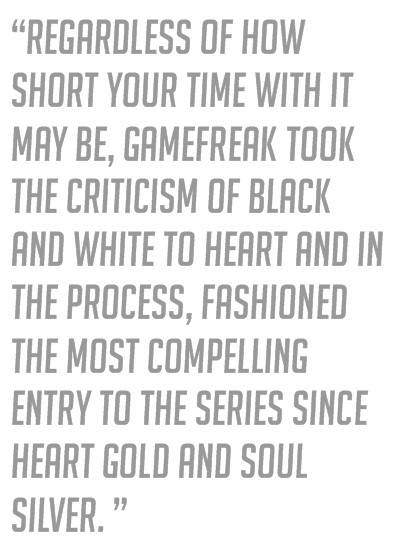 cut out that tedious fluff that’s held down the series from appealing to a bigger scale, but doing so without alienating the loyal fan base that clings to the tedium because it’s all optional.
cut out that tedious fluff that’s held down the series from appealing to a bigger scale, but doing so without alienating the loyal fan base that clings to the tedium because it’s all optional.
There are several apps at your disposal in your journey through the region of Kalos. Two of these apps supplement the creature training applies the same logic of steadfast mechanics that expedite all of the processes that go into deputizing direction of growth you want to take for the monsters in your party, and the other is the most polished implementation of multiplayer within the franchise yet. Super Training is significant with that same line of philosophy towards improving X and Y to be more accessible and faster; for those of you who never understood what “effort Value” training was because of the ridiculously esoteric nature that the mechanic was surrounded in for the last seventeen years, it’s now an acknowledge thing with the interface. Yeah, it took five generations of monsters to get it right but the earned points are now visible in play and in practice, is capitalized in a much more efficient way that ingeniously works in harmonious synergy with the new experience share dynamics. See, the way you would normally train Effort Value is through individual battle with creature who excel in a certain stat, so for example, if your Pokémon defeats a really fast Scyther—the victorious creature will get an invisible bonus to its speed capabilities, you can only surmise just how monotonous dedicating attention to something like that can be.
Super Training eliminates the hardship of traditional EV training in two ways; a simple and somewhat short soccer mini-game that’s aimed to advance one particular stat, and the other are specialized punching bags that your monsters pummel every couple of steps you take, with point collection operating in this almost Tamagotchi-like way. Admittedly, the soccer mini-games aren’t anything to write home about, but they’re short enough and easy enough to focus on long enough to earn the prized punching bags that help train your Poké without investing all of the time into individually training it in battle.
The Pokémon-Amie app manages to provide fan service and incentive to advance your creatures as it places any monster you choose into a playroom on the touch screen to mingle with like a virtual pet. Every single Pokémon is beautifully articulated into a gorgeous 3D model that all interacts in a surprisingly organic and individual manner; Imagine Nintendogs but with an adorable 2'00" tall lizard that breathes fire. Players can either feed it Poképuffs, pet it with the stylus, or make faces with it using the 3DS’ front-facing camera, each monster will react differently and will net you a certain amount of affection. These affection points are required certain monsters to evolve, and again make the process a hell of a lot easier. Coupled with its own share of uninspired mini-games, the playroom mechanic is fun for both fans and anyone new to Pokémon in a genuinely gratifying way.
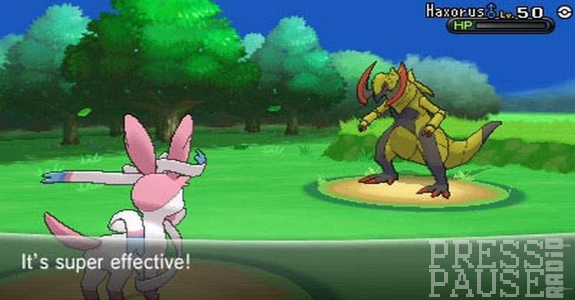
The last app is the PSS or Player Search System, is a nifty feature that allows you to battle, trade, or consort with friends or even strangers at any time in the game and any location whatsoever again correlating with the fast and seamless nature of X and Y. The display shows lists of registered friends who’re actively online along with random players from around the world how available to challenge or barter with and has a ton of other features that make this installment the closest that Game Freak has ever come to applying MMO mechanics. Though Light in nature, chatting and consorting to all the communal aspects of Pokémon when playing online in X and Y is effective and appreciatively easy which is a relief because if there’s one factor that hurts X and Y it the end game.
With all the unified mechanics that keep the game non-stop, getting to the end of it feels like it’s shorter because the tedium of the pace is refined this go around, there’s hardly any grinding required and yet so much opportunity to do it. The realization that potential for additional content goes to waste is cruel by the time you’re done doing the paltry set of endgame quests, though whether or not GameFreak and Nintendo capitalize on possible DLC ventures is a mystery, the Big N’s track record is definitely a cause for concern.
Regardless of how short your time with it may be, GameFreak took the criticism of Black and White to heart and in the process, fashioned the most compelling entry to the series since Heart Gold and Soul Silver. If you’re a disenchanted Pokemon fan that’s mulling it over, or even a slightly curious window shopper, jump pack into the pool, because the water’s amazing this time around.
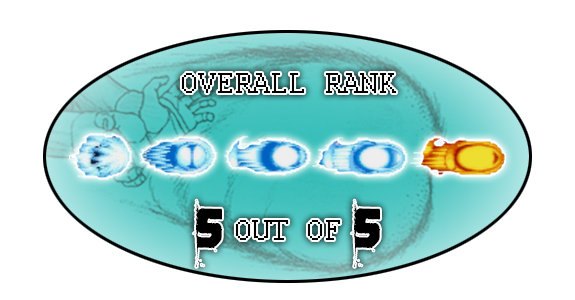
 Mega evolutions,
Mega evolutions,  Nintendo 3DS,
Nintendo 3DS,  Oh Fuck...,
Oh Fuck...,  Online,
Online,  Pokemon,
Pokemon,  gotta catch them all | in
gotta catch them all | in  QCF Reviews
QCF Reviews 









